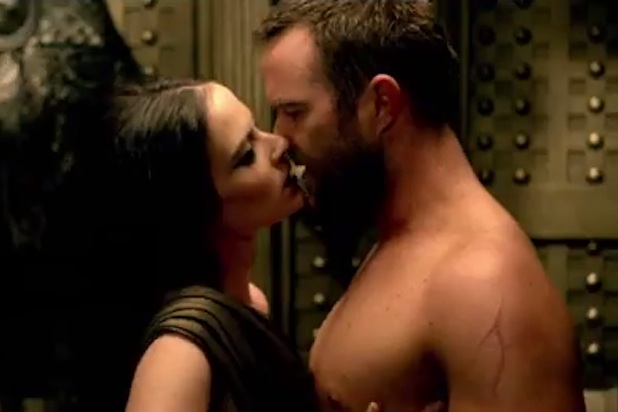 In these days of endless sequels, prequels, remakes, reboots, remaquels, reimaginings, updates, by-the-numbers tentpole franchise installments, rip-offs, spin-offs, cash-ins, and bland PG-13 superhero blockbusters produced for the sole purpose of maintaining a studios’ legal claim to a titles’ intellectual property rights, it is refreshing to behold an unashamedly gory big budget action epic that wants nothing more than to live in the universe of its blood-drenched antecedent. Sharing 300’s geography and chronology makes Rise of an Empire a side-quel. Or a paralle-lquel. Concurrent-quel? We’re still workshopping the lexicon.
In these days of endless sequels, prequels, remakes, reboots, remaquels, reimaginings, updates, by-the-numbers tentpole franchise installments, rip-offs, spin-offs, cash-ins, and bland PG-13 superhero blockbusters produced for the sole purpose of maintaining a studios’ legal claim to a titles’ intellectual property rights, it is refreshing to behold an unashamedly gory big budget action epic that wants nothing more than to live in the universe of its blood-drenched antecedent. Sharing 300’s geography and chronology makes Rise of an Empire a side-quel. Or a paralle-lquel. Concurrent-quel? We’re still workshopping the lexicon.
Director Noam Murro lovingly copycats the structure, pacing, penchant for voiceover, and aesthetic (and even the release date) of Zack Snyders’s 2007 film, itself a loving ink-to-cinema transcription of Frank Mille Miller’s mini-novel. One issue that will not weigh as heavily in the reaction to this new 300 fable is the arguably problematic distortion of ancient history and its place vis– -vis current events. After some critics transmogrified Snyders’s interpretation of a 1998 comic book into perverse commentary on the Global War on Terror and Operation Iraqi Freedoms’ “The Surge” phase, Snyder somewhat unfairly earned a reputation as a self-condemning, aloof, homophobic, and possibly racist director of very long music videos that double as propaganda. Others watched 300 and just enjoyed seeing that gray giant shedding his chains and almost taking out Leonidas’ left eye.
 Rise of an Empires’ puritanically liberal detractors will howl about the all-white protagonists battling mostly brown-skinned villains, about the warmonger speechifying that vaguely resembles something a hawkish American politician might murmur in his wet dreams, or about the plots’ central fiction of a heroic democracy fighting against the establishment of a worldwide Persian caliphate. Those critics might be correct, but to take this film seriously is to confront a Spartan phalanx in a bottlenecked mobility corridor. (Translation for those untrained in military strategy jargon: Big mistake.) Rise of an Empires’ many anachronisms and moments of pure cartoonishness will have the last laugh over historical fact-checkers and the do-gooders who rage about insensitivity in a movie starring this guy:
Rise of an Empires’ puritanically liberal detractors will howl about the all-white protagonists battling mostly brown-skinned villains, about the warmonger speechifying that vaguely resembles something a hawkish American politician might murmur in his wet dreams, or about the plots’ central fiction of a heroic democracy fighting against the establishment of a worldwide Persian caliphate. Those critics might be correct, but to take this film seriously is to confront a Spartan phalanx in a bottlenecked mobility corridor. (Translation for those untrained in military strategy jargon: Big mistake.) Rise of an Empires’ many anachronisms and moments of pure cartoonishness will have the last laugh over historical fact-checkers and the do-gooders who rage about insensitivity in a movie starring this guy:
 No one can say Snyder lacks skills in the field of cinema action clarity, and Murro evidently shares Snyders’s desire to wash away forever the stench of shaky-cam and quick-cuts in filmed combat. The terms “speed ramping” and “slo-mo” have somehow gained negative connotations, but that is because a lot of moviegoers are imbeciles. Rise of an Empire abandons those trendy, retrograde notions of restraint and taste in favor of giving the audience exactly what it expected when they saw this title in the first preview — a distilled form of carnage presented as pornography.
No one can say Snyder lacks skills in the field of cinema action clarity, and Murro evidently shares Snyders’s desire to wash away forever the stench of shaky-cam and quick-cuts in filmed combat. The terms “speed ramping” and “slo-mo” have somehow gained negative connotations, but that is because a lot of moviegoers are imbeciles. Rise of an Empire abandons those trendy, retrograde notions of restraint and taste in favor of giving the audience exactly what it expected when they saw this title in the first preview — a distilled form of carnage presented as pornography.
Marshaling all the powers of modern camera technology, an early opening shot refuses to cut away until we’ve seen dozens of swordplay maneuvers and gallons of computerized comic book blood. Murro reprises this extended-take single-shot technique during the climax in a wondrously silly scene involving a horse jumping from boat wreckage to boat wreckage. Rise of an Empire should grab a drink sometime with Timur Bekmambetov’s Abraham Lincoln: Vampire Hunter so they can discuss the finer points of awesome CG equine action.
 Sullivan Stapleton as Themistokles resembles a 210-pound chipmunk. Rise of an Empire knows that he cannot fill Gerard Butlers’ sandals, and so the story calls for him to play up this perceived inadequacy. He is a great warrior, but he makes mistakes and lacks Leonidas infinite confidence. How much glory can a man really seize if he doesn’t go all the way to martyrdom? Psychoanalytically inclined viewers will detect a certain meta quality in his character as the director’s stand-in. No one respects Themistokles as much as everyone admires & exalts Leonidas; this reading of the narrative reveals the director Murro’s transference of desire to make Zack Snyder & Frank Miller proud while realizing he’ll never quite be the true, original auteur of 300.
Sullivan Stapleton as Themistokles resembles a 210-pound chipmunk. Rise of an Empire knows that he cannot fill Gerard Butlers’ sandals, and so the story calls for him to play up this perceived inadequacy. He is a great warrior, but he makes mistakes and lacks Leonidas infinite confidence. How much glory can a man really seize if he doesn’t go all the way to martyrdom? Psychoanalytically inclined viewers will detect a certain meta quality in his character as the director’s stand-in. No one respects Themistokles as much as everyone admires & exalts Leonidas; this reading of the narrative reveals the director Murro’s transference of desire to make Zack Snyder & Frank Miller proud while realizing he’ll never quite be the true, original auteur of 300.
Is it fair to withhold the Visionary label from a filmmaker so clearly in thrall to the occupation of imitation? Of course, yes, but, as anyone who has seen William Friedkin’s To Live & Die in L.A. or Alan Rudolph’s The Moderns knows, a good counterfeiter can produce great, or at least interesting, art. In this case, Murro has apparently fallen in love with symmetrical compositions:
 The first rule of copying Snyder’s style is “Make it look cool for the promotional posters.” Luckily for audiences not hoping to see a mere series of precisely blocked still paintings, Rise of an Empire also bursts with long sequences of kinetic action. This is not another Only God Forgives situation, whereby each scene is a stilted money shot in static repose.
The first rule of copying Snyder’s style is “Make it look cool for the promotional posters.” Luckily for audiences not hoping to see a mere series of precisely blocked still paintings, Rise of an Empire also bursts with long sequences of kinetic action. This is not another Only God Forgives situation, whereby each scene is a stilted money shot in static repose.
Homoeroticism:
We all wanted the 300 side-quel to inspire machismo-challenging “Rise of an Erection” headlines, but then Eva Green had to step in and dominate the film as Artemisia, Xerxes step-sister & primary military commander. That’s Eva & Artemisia with an “a,” which means she’s a she, which threatens the homoerotic foundation of the 300 franchises. To her credit, though, Artemisia is a great character, and it will be a shame when Ms. Green receives zero awards consideration at the end of this calendar year.
 Sure, this episode of 300 dabbles in enough homoeroticism to make its gaygasmic predecessor proud, but it’s just not the same festival of pure man meat when you’re forced to admire a pretty actress’s eye shadow, cleavage, & impeccably sexy action-posturing every couple of minutes. At one point, Artemisia kisses a freshly severed head on the lips, and she makes the audience want to be that decapitation victim. It’s all very confusing for our hormones.
Sure, this episode of 300 dabbles in enough homoeroticism to make its gaygasmic predecessor proud, but it’s just not the same festival of pure man meat when you’re forced to admire a pretty actress’s eye shadow, cleavage, & impeccably sexy action-posturing every couple of minutes. At one point, Artemisia kisses a freshly severed head on the lips, and she makes the audience want to be that decapitation victim. It’s all very confusing for our hormones.
If the Spartans of 300 were gym bunnies, then the Athenians of 300 2: 300er are bears. Their abdomens are less defined. Even with the benefit of IMAX 3D, the striking linear sinew segments twixt trapezius & pectoral is less Mr. Olympia-worthy in this corner of ancient Greece. Their bodies are neither tan nor naturally glistening. They wear skosh more clothing than the Spartans.
 Yes, the central historical event loosely depicted by Rise of an Empires’ 600 visual effects artist/technicians is “The Battle of Salamis,” but the writers inexplicably chose to leave that juicy bit of gayness as silent subtext comprehensible only to Greek history nerds. Widowed Queen Gorgo has no such reservations; she embraces confused sexual tension when she sees it, opening her conversation with hero Themistokles with this honest observation: “You’ve come a long way to stroke your cock and watch young men train.”
Yes, the central historical event loosely depicted by Rise of an Empires’ 600 visual effects artist/technicians is “The Battle of Salamis,” but the writers inexplicably chose to leave that juicy bit of gayness as silent subtext comprehensible only to Greek history nerds. Widowed Queen Gorgo has no such reservations; she embraces confused sexual tension when she sees it, opening her conversation with hero Themistokles with this honest observation: “You’ve come a long way to stroke your cock and watch young men train.”
 Other vaguely scrotum-tingling moments include the lines “Ram them! Go through them!” barked as a naval command and “We chose to die on our feet, rather than live on our knees!” delivered as some kind of inspirational motto.
Other vaguely scrotum-tingling moments include the lines “Ram them! Go through them!” barked as a naval command and “We chose to die on our feet, rather than live on our knees!” delivered as some kind of inspirational motto.
Rise of an Empire’s one actual sex scene goes spectacularly awry; it’s an act of furtive, forbidden foreplay that escalates to consensual violence, and it must be seen to be believed. Witnessing an impromptu couple compete to give each other the worst ever case of blue balls has rarely been so fun.
 The dialogue’s most glorious achievement is Artemisia’s climactic line, “You fight harder than you fuck!” Literature professors go their whole lives without ever seeing a more badass laugh line. “You fight harder than you fuck!” is a verbal dagger that emanates an impressively balanced aura of both insult & compliment, a perfectly terse distillation of the ethos that finds pleasure in violence and sublimates the thrusting of spears for that of the human pelvis. And thatÂs the film in microcosm — giving the 300 fans what they want, in a generous & impressive package, and yet not allowing them to escape the embarrassment they should derive from their own grotesque taste in art & entertainment.
The dialogue’s most glorious achievement is Artemisia’s climactic line, “You fight harder than you fuck!” Literature professors go their whole lives without ever seeing a more badass laugh line. “You fight harder than you fuck!” is a verbal dagger that emanates an impressively balanced aura of both insult & compliment, a perfectly terse distillation of the ethos that finds pleasure in violence and sublimates the thrusting of spears for that of the human pelvis. And thatÂs the film in microcosm — giving the 300 fans what they want, in a generous & impressive package, and yet not allowing them to escape the embarrassment they should derive from their own grotesque taste in art & entertainment.
Leave a Reply